Listen to the world's languages - part 3: Algonquian!
We've posted here before about sites online where you can listen to audio samples from the worlds languages, see part 1 and part 2 (or check the tag listentotheworldslanguages). Go have a look, there are plenty of exciting sites where you can have a listen to the diversity of our planet!
On the site of the Algonquian Linguistic Atlas you can listen to audio samples from different categories (greetings, feelings, at the store, etc) from many different algonquian languages. The idea is similar to the Sound Comparisons site that we covered before where you can listen to European languages.
What is so great about this site is that you can pick a word or phrase, say "I'm Lazy", and listen to how it sounds in the different languages and see how they are similar and different. You can see the chains of contact and shared genealogy and what changes and what is more stable.
 Each audio sample is accompanied with a transliteration into latin script and sometimes also in Cree syllabary, an awesome writing system used by many Algonquian languages. To the right you can see a sign in Québec in Eastern Cree, French and English. You can read more about the writing system on omniglot here. I believe that the specific variety that they are using is Easter James Bay, you can also read more here about standardisation of this writing system.
Each audio sample is accompanied with a transliteration into latin script and sometimes also in Cree syllabary, an awesome writing system used by many Algonquian languages. To the right you can see a sign in Québec in Eastern Cree, French and English. You can read more about the writing system on omniglot here. I believe that the specific variety that they are using is Easter James Bay, you can also read more here about standardisation of this writing system.
The set of languages also includes the mixed language Michif, which has something as funky as cree verbs and french nouns. A mixed languages is a kind of contact language that retains more or less intact parts from i's parents, has no/little simplification and is created by bilinguals - in this case children of french speaking fathers and cree-speaking mothers. You'll also spot loanwords from English and French in other algonquian languages as well, such as the speaker Reta Sands who speaks Nishnaabemwin and says 'bozhoo' (their transliteration) for 'hello'.
If you want to know more about the language situation in Canada right now I can highly recommend having a look at their census, link to the article on aboriginal languages here. Canada has one of the best censuses I've seen when it comes to languages, it goes back to the 1930's and it asks not only about what language people speak but what they grew up with, what they now use mostly, what they speak at home and what they speak at work.
Algonquian is a family within the larger top-level* family Algic. There are approximately 45 languages alive today of this family and they are spoken in Canada and the northern part of the United States. Here below is a map from Glottolog. The dots represent languages of the Algic family, the red ones being Algonquian and the two other ones being Yurok (blue) and Wilyot (yellow). These two are sometimes classified as one group; Ritwan.
Let's celebrate all this Algonquianess with listening to some bilingual rap in French and Anicinâbemowin [alq], here's Samian from Québec.
* top-level family means that this group is not related to any other group genealogically, it represents the highest/lowest node in tree, the furthest point back in time. NB that not all linguists agree on these top-level points, Glottolog for example assumes more top-level families (443) than Ethnologue (141). On Algic they do agree, with the exception that Ethnologue places Yurok and Wilyot in one branch where Glottolog assumes them both as directly under Algic.
This time: The Algonquian Linguistic Atlas!
On the site of the Algonquian Linguistic Atlas you can listen to audio samples from different categories (greetings, feelings, at the store, etc) from many different algonquian languages. The idea is similar to the Sound Comparisons site that we covered before where you can listen to European languages.
What is so great about this site is that you can pick a word or phrase, say "I'm Lazy", and listen to how it sounds in the different languages and see how they are similar and different. You can see the chains of contact and shared genealogy and what changes and what is more stable.
The set of languages also includes the mixed language Michif, which has something as funky as cree verbs and french nouns. A mixed languages is a kind of contact language that retains more or less intact parts from i's parents, has no/little simplification and is created by bilinguals - in this case children of french speaking fathers and cree-speaking mothers. You'll also spot loanwords from English and French in other algonquian languages as well, such as the speaker Reta Sands who speaks Nishnaabemwin and says 'bozhoo' (their transliteration) for 'hello'.
If you want to know more about the language situation in Canada right now I can highly recommend having a look at their census, link to the article on aboriginal languages here. Canada has one of the best censuses I've seen when it comes to languages, it goes back to the 1930's and it asks not only about what language people speak but what they grew up with, what they now use mostly, what they speak at home and what they speak at work.
Algonquian is a family within the larger top-level* family Algic. There are approximately 45 languages alive today of this family and they are spoken in Canada and the northern part of the United States. Here below is a map from Glottolog. The dots represent languages of the Algic family, the red ones being Algonquian and the two other ones being Yurok (blue) and Wilyot (yellow). These two are sometimes classified as one group; Ritwan.
Let's celebrate all this Algonquianess with listening to some bilingual rap in French and Anicinâbemowin [alq], here's Samian from Québec.





Comments
Post a Comment